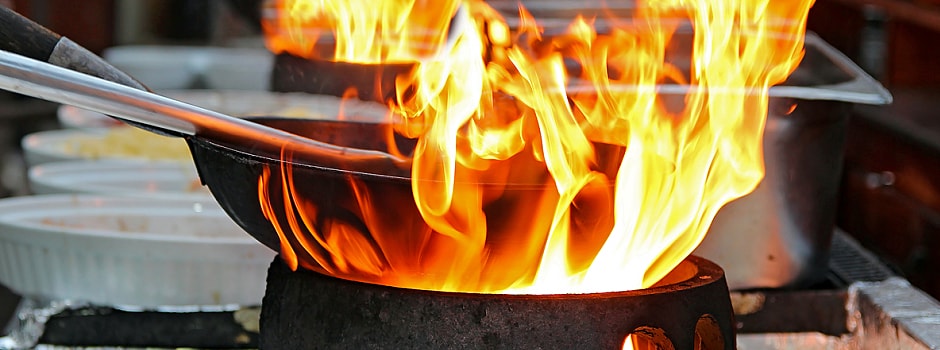You can't eliminate injury risks from your kitchen, but being conscious of cooking safety can help reduce some of the dangers. For example, figures from the Bureau of Labor Statistics show that burns are especially common in the hospitality industry. Restaurants are filled with burn risks—hot surfaces, open flames, fat in a fryer, and boiling water in pots—but the likelihood of a serious burn can decrease if you make your kitchen as safe as it can be. Here are some tips to keep in mind.
Determine Your Risks
Start by determining whether there are any special risks that are unique to your own kitchen. Look back at every burn incident you've experienced, including near misses where accidents were luckily avoided. If you can see a pattern centered around a specific station or piece of equipment, identifying the risk factors at that station should be your highest priority. If there's no history of burns, or if there's no apparent pattern, ask your staff if there are specific stations or duties they consider to be risky or unsafe. Their concerns might provide useful guidance.
Follow These Specific Guidelines
Most cooking safety advice boils down to a few relatively straightforward, common sense rules. You can find them outlined on the Occupational Safety and Health Administration's website. State agencies are also a good source of safety-related materials. Based on their advice, here are some tips that may help you avoid the most common hazards:
Fryers and Hot Fat
- Don't overfill fryer baskets.
- Don't fry wet foods without drying them first, and don't fry frozen foods without removing surface ice crystals.
- Cool fat before draining it or transporting it through the kitchen.
- Never lean over a fryer.
Boiling Water and Hot Liquids
- Provide waterproof aprons at splash-prone stations.
- Never carry a large, full pot by hand. Instead, roll it on a cart or dolly.
Steamers, Ovens, and Other High-Risk Heat Sources
- Stand to the side when opening a steamer, steam jacket kettle, oven, or other source of steam or hot air.
- Never reach over a pot or piece of equipment that's vigorously steaming.
- Wear moisture-resistant, heat-proof gloves and use long utensils to handle or rearrange food inside equipment.
Microwaves
- Use vented containers, so steam can easily escape. If the food is covered with plastic wrap, puncture the plastic.
- Mount the microwave low enough so that staff can easily reach in—not up—to remove food.
- Treat everything as dangerously hot until proven otherwise, and wear heat-proof pads or oven mitts.
Address Issues in the Kitchen
Assessing your kitchen's workflow, and addressing any potential physical hazards, can also reduce the risk of burns. For example, if an employee slips on a wet or oily floor, they could easily spill hot fat or liquids, or grab a hot surface to break their fall. You can minimize that risk by providing nonskid flooring or mats. Other simple steps you can take include:
- Keeping flammables (especially oil) away from sources of open flame.
- Organizing your workflow to help minimize crowding near fryers, steamers, and other high-risk areas. This may reduce the risk of burn-inducing collisions or accidental contact with hot surfaces.
- Using splash guards in areas where hot fat and liquids are used, and if possible, installing physical barriers to help protect employees at neighboring stations.
- Providing plenty of dry towels, pot holders, oven mitts, steam-proof silicone gloves, and other appropriate protective gear for your cooks.
- Making sure fire extinguishers and first-aid kits are close by, and not in places where employees will need to reach over or past heat to access them.
Burn-Proof Your Cooks
You should consider including burn prevention in your training and orientation for new hires, and monitor your establishment for potentially dangerous situations or behaviors. A few other considerations:
- Cooks should wear shoes with nonskid soles and closed (splash-proof) toes.
- Long-sleeved chef jackets may help provide protection against forearm burns.
- Provide training on first aid for key staff members, or hire employees that are already trained in first aid. Try to ensure that there's at least one trained person working each shift.
- Encourage employees to bring potential hazards to your attention as they develop.
As long as food is cooked with heat, burns will continue to be a hazard for restaurant workers. To make your kitchen as safe as possible, consider these tips. You may need to enforce good workflow organization and safety-minded habits, but the result will be a much safer establishment.
Related Articles

How to Prepare for a Health Inspector Visit
It's important to prepare your kitchen, and yourself, for a visit from the health inspector. Here are some tips to help you be successful.

How to Create an Emergency Action Plan for Your Restaurant
It's impossible to foresee every potential emergency, but having an emergency action plan will help you bounce back. Here are some tips to keep in mind.

High Volume Meets Consistent Quality
Meeting the demands for high volumes, environmental conditions, and turn-key operation
